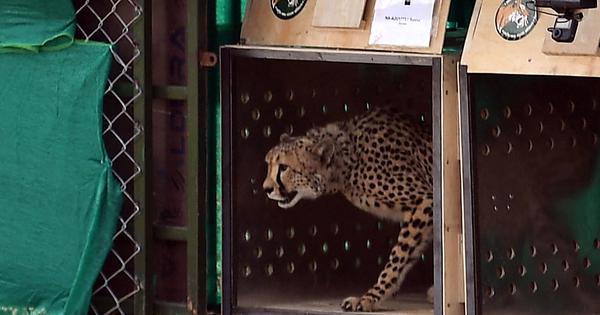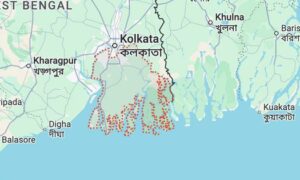
In August, Jwala, one of eight cheetahs translocated from Namibia to Kuno forest in Madhya Pradesh, went on a long stroll.
Crossing the forests of Kuno, she ventured north-west and entered the state’s villages. There, she paused to prey on cattle and goats. She then moved further, crossed the Seep river and entered Rajasthan. In all, she covered approximately 100 km, and entered tiger territory – the Ranthambore National Park.
Officials who were tracking her movements closely were not surprised by the long distance she travelled – after all, by June, just three months after being released into the wild from the enclosures in which they were initially kept, the mother and her four cubs had already become Kuno’s “most travelled cheetahs”.
But they worried about the risk to Jwala in tiger territory. So, they decided to intervene – they tranquilised her and brought her back to Kuno by road.
Since September 2022 when the cheetah project was launched, this was among several such instances reported in the media in which cheetahs wandered beyond Kuno, across the Rajasthan border or into human settlements, and were tranquilised and returned.
For the project, 20 cheetahs were flown from Namibia and South Africa to Kuno. Of those, 11 adults have survived, along with 16 cubs born in India. (One of Jwala’s cubs, which grew into a sub-adult, died on September 15 – this was the first such death that officials suggested could have occurred due to a fight with a leopard.)
As the project enters its fourth year, of the original adults, five are in soft bomas, or enclosures, while six, along with 11 cubs born in India, are currently free-ranging.
Experts say that this movement of the free-ranging cheetahs outside of Kuno is natural given the extent of home ranges that cheetahs are known to require. They point out that Kuno has an area of 750 sq km to house 21 cheetahs – that is, it can hold three cheetahs for every 100 sq km. This, they say, is severely inadequate.
In fact, a month after the cheetahs were released in Kuno in 2022, Arjun M Gopalaswamy, founder and chief scientist at Carnassials Global, a conservation consultancy, published a paper with seven other scientists, which suggested that the plan had “substantially overestimated cheetah carrying capacity” in Kuno.
“Nowhere in free-ranging conditions in Africa do cheetahs have small home ranges,” Gopalaswamy told Scroll. “Even in very high-prey areas, such as the Masai Mara study I was involved with, males ranged roughly 488 sq km-966 sq km and females about 461 sq km-720 sq km, with ranges shifting as prey migrated.”
Officials involved with the cheetah project had defended calculations of Kuno’s carrying capacity and critiqued independent experts. They suggested that such experts erred in extrapolating assumptions of cheetah home ranges and the animals’ use of space from African habitats to the Indian context. This comparison, they said, “lacked scientific rigour”.
But the most recent report of the National Tiger Conservation Authority, the project’s implementing agency, confirms that indeed, in the last three years, several cheetahs have been using vast home ranges, extending far outside Kuno’s limits.
The report, prepared in 2024, provides specific details on the movements of two of the animals, Veera and Pawan. Using two different methodologies, it estimates that Pawan had used either around 800 sq km or around 1,800 sq km, while Veera had used either around 5,200 sq km or 7,400 sq km.
Gus Mills, a wildlife biologist who has worked on large carnivores, including cheetahs, in South Africa and Botswana for over 50 years, was a co-author of the 2022 study. “As we predicted, it’s being borne out now that Kuno could never contain a viable population of the cheetahs,” he told Scroll over phone.
Scroll emailed the National Tiger Conservation Authority, which is the project’s implementing agency, as well as the ministry of environment and forests and the head of Project Cheetah’s steering committee, seeking responses to criticisms about estimations of the space that the cheetahs would need.
This story will be updated if they respond.
Evidence of cheetah movement beyond Kuno
The National Tiger Conservation Authority’s 2024 progress report was not the first in which it noted that cheetahs were likely using ranges that extended beyond Kuno.
A 2023 progress report had calculated home ranges for all the project’s free-ranging cheetahs. It found that while the cheetahs travelled distances between 2 km and 9 km each day, the total area that they treated as their home ranges was between 3 sq km and 5,500 sq km.
The 2024 report also contains details about the extent and direction of straying incidents.
It notes that between December 2023 and June 2024, forest officials brought back cheetahs to Kuno four times. Twice, the animals walked up to Karoli and Baran in Rajasthan, about 50 km and 70 km from Kuno respectively. The other two times, they remained in Madhya Pradesh, but went beyond the forests of Kuno to Mohana and Joura in Madhya Pradesh, about 30 km and 60 km, respectively, from Kuno.
The report stated that retrieving cheetahs to Kuno was necessary to mitigate against the possibility of harm to both cheetahs and humans, since both could be at risk if an animal moved to a human settlement. It noted that in such situations, a veterinary team was quickly notified and would “intervene to safely capture and release the cheetah” within the boundaries of Kuno National Park.
Further, the report argued that apart from protecting both humans and cheetahs, this strategy “reinforces the cheetah’s natural homing instinct”.
Experts disagree. “Normally, when animals move out of an area, it’s a good sign that the area has reached whatever capacity is for that species,” Mills said. “Catching them and bringing them back is a futile exercise. And we can already see this in India, officials move them back and the cheetahs do not stay in Kuno’s area.”
Mills added that this movement of cheetahs after being brought back is not unique to Kuno – it has occurred even in habitats that are generally considered more suitable for the animals than Kuno.
For instance, even in Namibia, cheetahs translocated from one site to another did “extensive exploration movements” of several thousands of square kilometres during the first six months”, a 2023 letter by Namibian cheetah experts on the introduction of cheetahs to Kuno noted. The letter referred to various studies on cheetahs across the world and predicted that Kuno’s cheetahs would exhibit similar behaviour, and as a result would likely come into some conflict with livestock farmers.
Slow development of cheetah corridor
The problem of cheetahs wandering outside Kuno acquires particular urgency in light of the fact that authorities have not made significant progress yet with plans to establish other populations of the animal and link them to Kuno through corridors.
Such a system would allow the animals to develop a healthy metapopulation – a term that refers to a population of cheetahs in which individuals move between various sites naturally. Creating such a metapopulation is vital since it can ensure that even if individual local populations go extinct, the overall metapopulation persists.
Having such healthy interconnected forests could also allow cheetahs to move swiftly through the region with minimal interactions with humans, the tiger authority has noted.
Towards this end, in 2024, the tiger authority prepared a detailed “atlas” of the region’s “cheetah landscape”. Through maps, it identified all the nearby tiger reserves and national parks with details of land use, human density and livestock density.
But progress towards the creation of corridors seems slow so far.
The atlas identified three landscapes between Madhya Pradesh and Rajasthan that could be suitable for cheetahs – Kuno and Gandhisagar, with their surrounding forests, and one larger landscape that connected the two. Together, these landscapes include 12 protected areas apart from Kuno: among them are Ranthambore and Mukundra Tiger Hills in Rajasthan, and Madhav in Madhya Pradesh. The total cheetah landscape envisaged in the atlas can span across an area of 17,000 sq km if the corridors between them are connected well with dense forests.
Among many “actions required” to develop this landscape, the atlas noted, was the clear identification of corridors that cheetahs could use to move between different forests within the landscape.
In a meeting of the National Tiger Conservation Authority this April, a standing committee member suggested that to follow through on this approach to the cheetah project, “a joint collaboration” would be needed between Madhya Pradesh and Rajasthan.
In April this year, two adult cheetahs were moved from Kuno about 250 km away to another sanctuary in the state, Gandhi Sagar, to establish a second home there.
But in August, the Madhya Pradesh government refused to sign a memorandum of understanding with the Rajasthan government to develop corridors in the broader cheetah landscape. The state did not provide any reason for this refusal, only noted that it intended to sign the memorandum at a later date.
But some experts argue that in any case, having a broader cheetah landscape interconnected with corridors would be “inadequate”, because in this instance, the sizes of the individual forests are too small for cheetahs to establish themselves as source populations.
Gopalaswamy explained that in free-ranging conditions, cheetahs have a distinct spatial ecology from other big cats: males hold widely spaced territories, while females and non-territorial “floater” males use the intervening areas, altogether at very low densities across very large landscapes. “That’s the pattern these cheetahs will be trying to establish,” he said, “But as expected, they’re repeatedly running up against human settlements and livestock.”
He added, “Cheetahs need more than corridors. They require large, prey-rich landscapes, whether national parks or other wilderness areas, of that scale to begin with.”
📰 Crime Today News is proudly sponsored by DRYFRUIT & CO – A Brand by eFabby Global LLC
Design & Developed by Yes Mom Hosting






